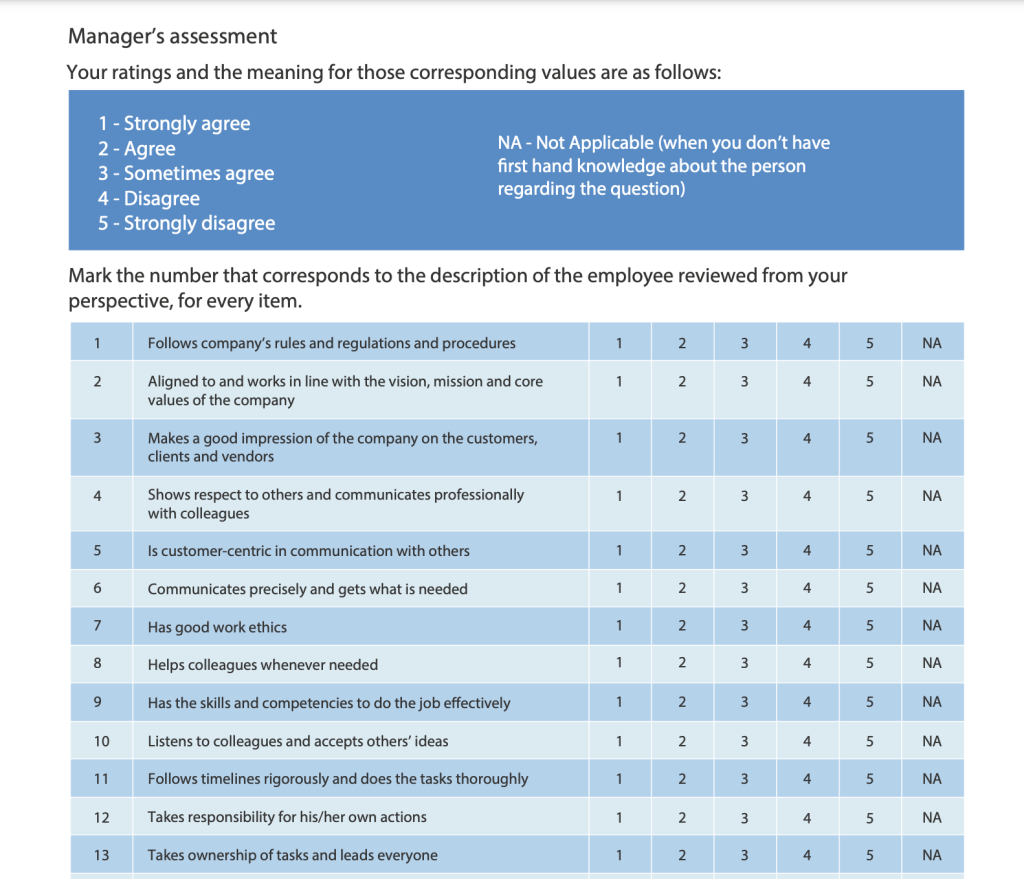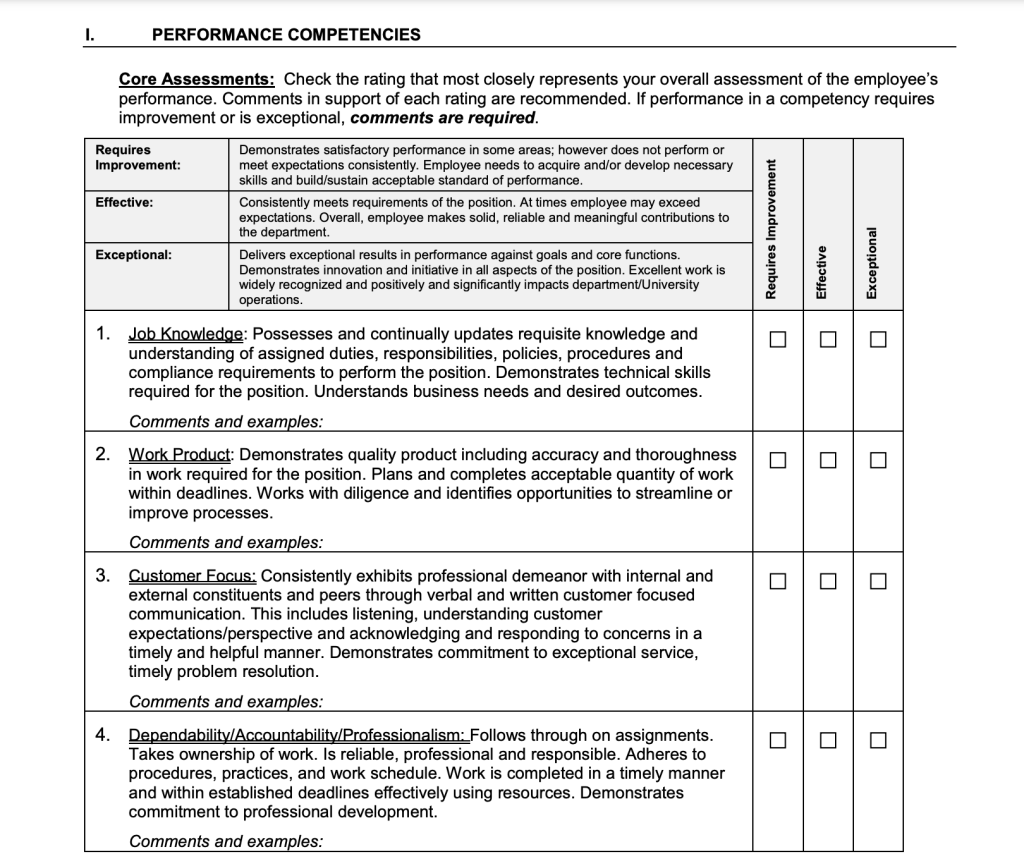What is an employee appraisal form, and how to make the most of it

An employee appraisal form is a tool for evaluating employee performance and identifying which areas need improvement, in order to guide their professional development. It is a structured way to document an employee’s contributions and achievements, strengths, and areas for growth, and an important part of team management. In this article, we’ll describe and demonstrate what is a performance appraisal form, how to choose or create an effective one, and how it can be leveraged to improve your employees’ performance.
Want to get the most out of your time?
Try DeskTime for free!
Try free for 14 days · No credit card required.
By signing up, you agree to our terms and privacy policy.

What is an employee appraisal form?
Essentially, an employee appraisal form is a document used to capture in detail an employee’s performance over a specific period. It includes various metrics and criteria that supervisors or managers use to evaluate an individual’s achievements, skills, behaviors, and overall effectiveness in their role. These forms provide an official and consistent record of employee evaluations, which allows managers to maintain objectivity and keep good track of performance changes over time. All of this makes it easier to track employee progress and support future decisions like promotions, salary increases, or training programs.
When structured properly, an employee appraisal form serves as both a feedback tool and a development plan, helping employees understand where they stand and how they can improve. For employers, it offers an objective way to assess each team member and make informed HR decisions.

The importance of a performance appraisal form for employees
A well-designed performance appraisal form for employees can have a significant impact on employee motivation and job satisfaction. It provides clarity regarding expectations and gives employees an opportunity to reflect on their work. Consistent evaluations also build transparency and fairness into performance management, reducing bias and creating a more supportive environment for employee growth.
For example, an employee who consistently meets project deadlines may score well on metrics like time management and reliability, but an appraisal form might reveal areas like team collaboration or communication that need improvement. By identifying these gaps, both the employee and their supervisor can get a comprehensive overview of employee strengths and shortcomings and set specific goals for improvement.
What to look for in a good employee appraisal form
Choosing or creating an employee appraisal form requires careful consideration to make sure that it meets your organization’s and team’s unique needs. Here are some important criteria to keep in mind:
- Alignment with organizational and team goals: A good performance appraisal form should tie into your company’s objectives. The criteria used to evaluate performance should be relevant to what success looks like in your organization and specific team. For instance, if innovation is a key value, make sure to include metrics for creativity and problem-solving.
- Clear, measurable metrics: The form should include both qualitative and quantitative metrics. Common areas to cover include job knowledge, communication skills, teamwork, reliability, and goal achievement. Additionally, you should have a section for open-ended feedback where managers can give more detailed insights.
- Customizability: If you’re selecting a pre-existing employee appraisal form template, make sure it can be customized. Every team, department, and role will likely have unique evaluation criteria, so it’s important to tailor the form to different teams and positions.
- Ease of use: The form should be simple for both managers and employees to understand and fill out. Complicated appraisal processes can discourage workers from filling them out honestly and in detail. So, use forms that are clear and concise.
- 360-degree feedback capability: The most informative performance appraisal forms allow input from multiple sources. Typically, 360-degree feedback includes self-evaluations, peer reviews, and feedback from managers and subordinates, if applicable. Just like in good research projects, gathering as many data points as possible produces a more detailed and objective view of the situation and allows for a higher quality assessment.

How to create a performance appraisal form for employees
Creating your own performance appraisal form can be as simple or as complex as necessary. The key is to ensure that it’s effective in evaluating performance and that it results in specific, actionable feedback.
- Define core competencies: Start by listing the essential competencies for each role. These may include technical skills, leadership qualities, or adherence to company values. Developing high quality competency models for each role can require expert consultations, but, to get you started, you can use existing competencies lists and refer to the employee’s job description.
- Set clear rating scales: Use a consistent rating scale (e.g., 1-5 or “Exceeds Expectations,” “Meets Expectations,” “Needs Improvement”) for each criterion. This provides a structured way to compare performance across different employees and allows to measure competency development over time.
- Include goal setting: Add a section for both short-term and long-term development goals. This is the true purpose of employee appraisal forms – to create a forward-looking development plan.
- Gather feedback: Ensure that the form allows space for open-ended feedback from both the employee and the manager. This promotes dialogue and ensures that the appraisal feels like a two-way conversation. This also allows to capture performance, engagement, and skills beyond the assigned role, especially useful in cases where the employee participates in projects that require a different skill set.

Be smart about your time!
DeskTime can help your team excel!
Employee appraisal form examples and templates
Looking for a sample of a performance appraisal form for employees? Here are some employee appraisal form examples that you can customize to fit your needs.
- Basic template: This type of form includes sections for job performance, goal achievement, and areas for improvement. It’s ideal for small businesses or startups looking for a simple, easy-to-use form.
Here’s what a basic objective-based employee appraisal form could look like:
Employee’s name:
Position:
Department/team:
Supervisor’s name:
Review period:
Date of performance review:
[Objective 1]: [rating]
[Objective 2]: [rating]
[Objective 3]: [rating]
[Objective 4]: [rating]
[Objective 5]: [rating]
Overall rating: [number] / 25
Achievements:
Areas of improvement:
Actions the employee took to improve from their previous review:
Professional goals:
Employee’s comments:
2. Behavior-based form: This version focuses on evaluating behaviors that align with company values, such as teamwork, leadership, and problem-solving skills.
Below is a fragment of a template created by Profit.co. Many more sites and blogs offer free templates, and there is an abundance of choice in paid performance appraisal forms, too.

3. Competency-based form: A more advanced option, this form evaluates specific competencies required for a particular role. It’s especially useful for technical or specialized positions.
Below is a basic competency-based employee appraisal form example from Brown University, available here:

4. Performance appraisal form example for managers: For leadership roles, this form is similar to the competency-based evaluation, but focuses on managerial skills such as team leadership, strategic thinking, and communication.
Use trackable performance data to enhance staff appraisal forms
Even the best quality 360-degree feedback leaves room for subjectivity, so it can be helpful to refer to solid data to reinforce employee appraisal forms. Tools like DeskTime provide real-time data on productivity, allowing managers to back up their appraisals with concrete evidence.
DeskTime tracks time spent on tasks, employee app and URL usage during working hours, project completion rates, and overall productivity, giving managers objective data about their employee efficiency. By integrating this data into your appraisal forms, you can provide more accurate feedback and set goals based on measurable performance metrics.
For example, if an employee’s appraisal shows excellent time management but low productivity, DeskTime can help pinpoint whether distractions or misallocated time are the root causes, allowing you to better address the issue in your feedback.
Performance appraisal examples for employees and managers
Let’s take a look at some performance appraisal examples for employees and managers that demonstrate how these forms can be used effectively:
- For employees: A developer might be evaluated on their technical skills, project completion rate, and communication with team members. Their performance appraisal form might reveal that while they excel in a specific are of coding or a programming language, they need to work on their collaboration skills. Setting specific goals in this specific area will help guide their professional development.
- For managers: A performance appraisal form for managers could evaluate leadership qualities, decision-making, and ability to meet team targets. If the form highlights a lack of clear communication, the manager can be encouraged to participate in leadership training programs.
Making the most out of employee appraisal forms
An employee appraisal form is much more than just a bureaucratic task – or at least, that’s how it should be looked at. Once you’ve gathered the feedback, make sure to create individual improvement plans for every employee, focusing on specific growth areas.
Whether you use a staff appraisal form or a performance appraisal form for managers, ensure that it’s well-structured, customized to your needs, and supported by data-driven tools like DeskTime. These forms, along with real-time performance tracking, can create a more engaged, productive workforce that’s ready to take on any challenge.
Did you find this article useful? Give it a clap!
Psst! You can clap more than once if you really loved it 🙂